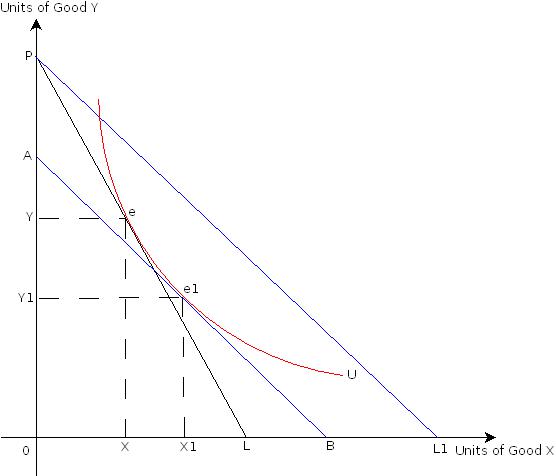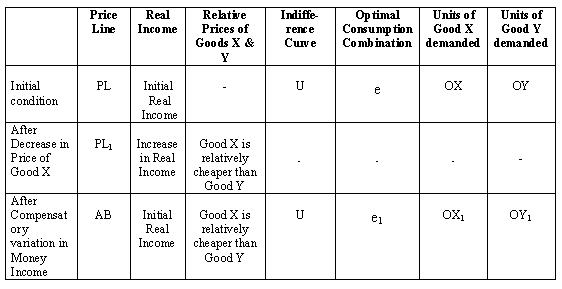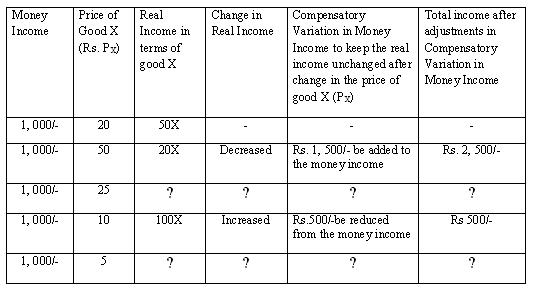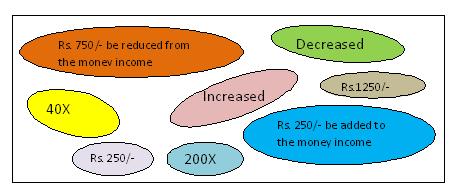INDIFFERENCE CURVES:SUBSTITUTION EFFECT
MICROECONOMICS

|
SUBSTITUTION EFFECT
|

|
Introduction |
In the previous section on income effect we have discussed how a consumer rearranges her/his optimal consumption combination, to once again maximize utility of her/his spendable income, as a response to a change in her/his income. We have also seen consumer's responses to income changes in case of different types of goods.

|
Learning Objectives |
| After reading this chapter, you are expected to learn about: understand 1. How consumers arrive at optimal consumption in response to change in relative prices?
| |
| Substitution Effect: Related Concepts |
In this section we are going to study substitution effect. In other words, understand how the optimal consumption combination changes as a result of change in the relative price alone, real income of the consumer remaining unchanged.
We need to understand here the meaning of relative price change and real income remaining unchanged.
In relative price change, comparison is between prices of two goods. For example, between goods X and Y, good X becoms relatively cheaper (costlier) when price of good X (Px)decreases (increases)with price of good Y remaining unchanged.
The real income on the other hand shows purchasing power of the money income. For the given money income, whenever price of a good changes then the purchasing power of consumer's money income increases and so also her/his real income. For example suppose a consumer is spending her/his money income on good X. When the price of the good X decreases, the consumer's purchasing power increases and with same money income she/he is able to purchase more of good X.
Now, a substitution effect shows change in the consumer’s optimal consumption combination on account of change in the relative price alone and thereby changes in her/his quantity purchased of goods X and Y, real income of the consumer remaining unchanged.
Note that consumer's real income changes whenever there is a relative price change. Then, how do we study substitution effect which shows changes in consumer's purchases on account of relative price changes, consumer's real income remaining unchanged?
A compensatory variation in money income method is used to neutralize the real income change that takes place on account of the relative price change. The consumer's money income is sufficiently adjusted to compensate her/him for real income changes on account of change in the price of a good.
Solve the following activity to gain adequate clarity on the concepts just discussed, before we move on to understanding substitution effect with the help of indifference curves.
| Hicksian Substitution Effect |
A substitution effect shows change in consumer's optimal consumption combination as a result of change in the relative price alone, real income of the consumer remaining unchanged. Substitution effect is shown in Figure 1. It starts with the initial optimal consumption combination attained at point e at which OX units of good X and OY units of good Y are purchased.

When the price of good X decreases, the budget constraint then becomes flatter, as the lower end point moves rightward. This is shown by budget constraint PL1. The real income of the consumer also increases. This increase in real income will be neutralized through Compensatory Variation in Money Income so that the real income of the consumer remains unchanged. In other words we need to reduce consumer's money income to bring her/him at initial real income level. This adjustment in money income shifts the budget constraint backwards and it is a parallel shift as shown by the price line AB.
The relative prices of goods X and Y are different on budget constraint AB than on the budget constraint PL. Good X is relatively cheaper to good Y on budget constraint PL1 than budget constraint PL. This is because budget constraint PL1 is obtained when the price of good X decreases, price of good Y remaining unchanged. Similarly, good X is relatively cheaper to good Y on budget constraint AB, as it is parallel to PL1.
Thus, good X is relatively cheaper to good Y on budget constraint AB than on budget constraint PL. However, Consumer's real income on budget constraint AB is same as her/his real income on budget constraint PL, as budget constraint AB is obtained through compensatory variation in consumer's money income.
Figure.1 shows that on the new budget constraint AB, obtained after compensatory variation in money income, the consumer attains optimal consumption combination at point e1 which is on the same indifference curve U and purchases OX1 units of good X and OY1 units of good Y.
Thus, consumer's movement from optimal consumption combination e to e1 shows substitution effect. Similarly, increase in her/his consumption of good X by XX1 and decrease in consumption of good Y by YY1 is on account of change in the relative price alone, real income of the consumer remaining unchanged.
Thus a substituion effect shows consumers preference for relatively cheaper goods. In the case of a substitution effect the consumer remains on the same indifference curve. Chart 1 presents a summary of Figure.1.

| Slutsky Substitution Effect |



